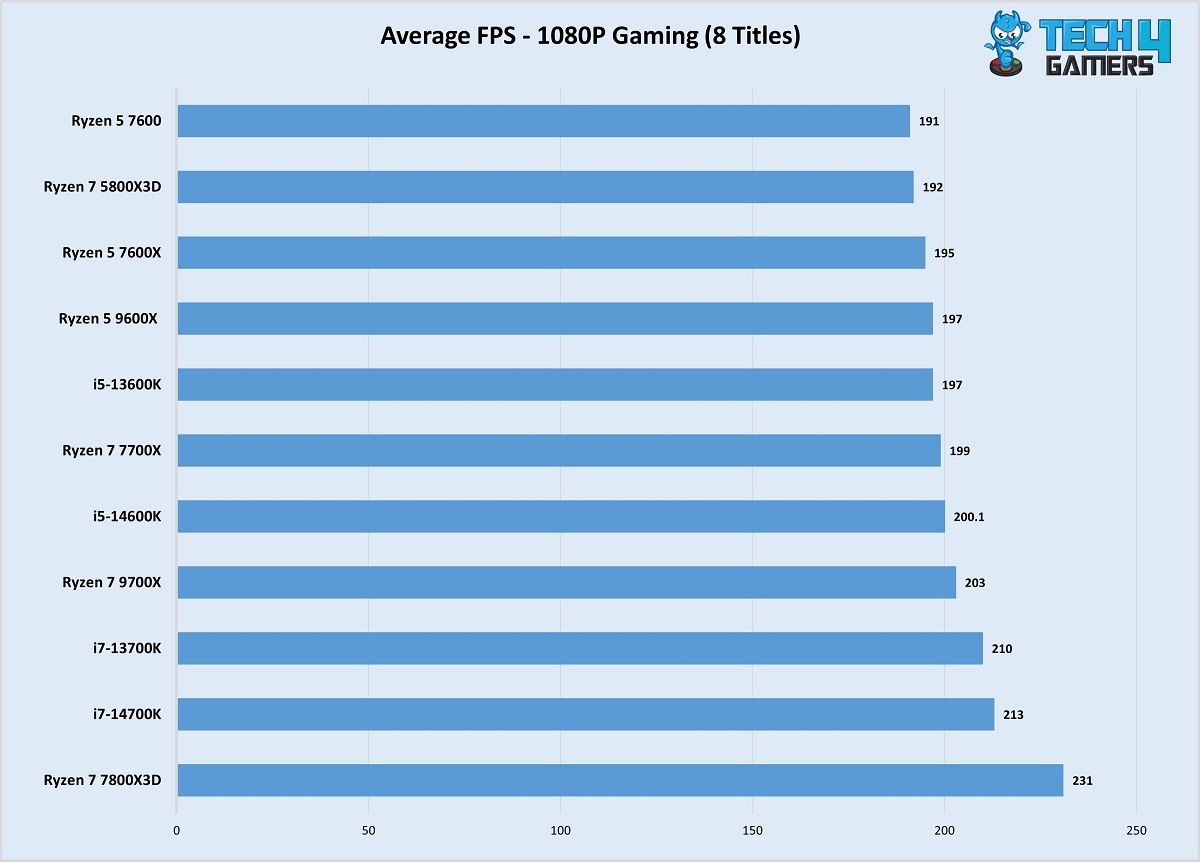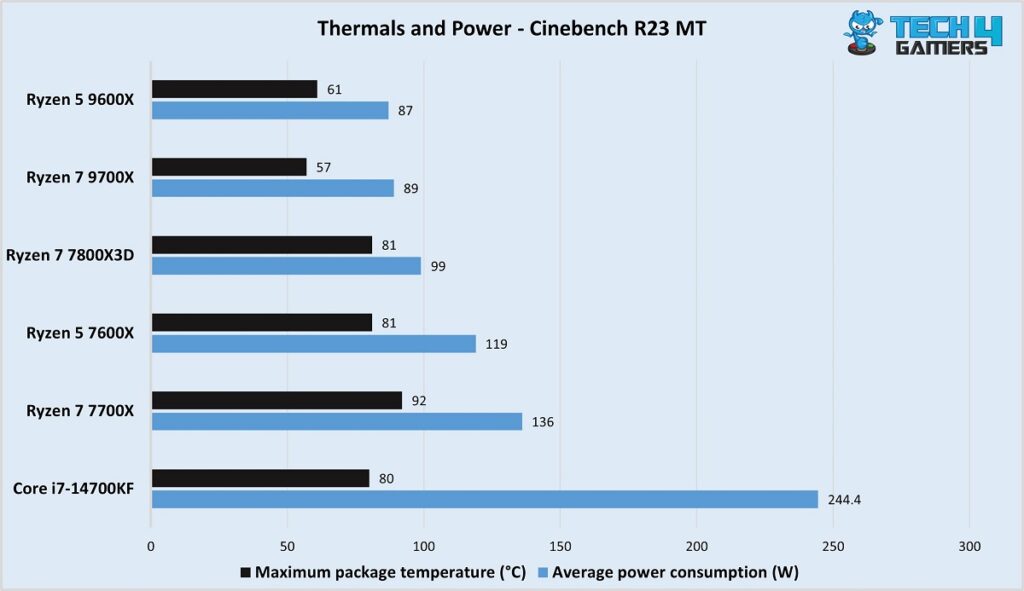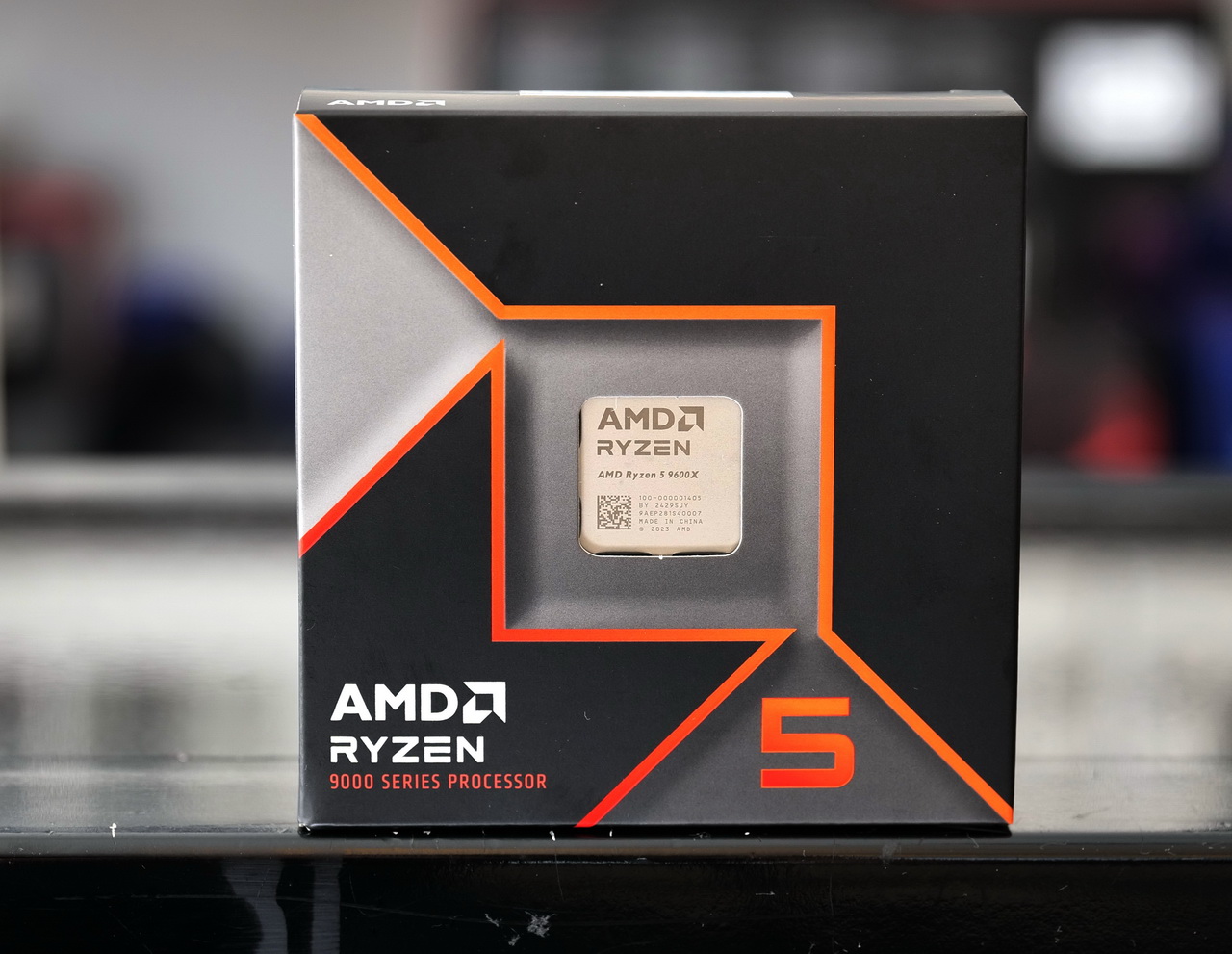Merely An Upgrade
Review Summary
The Ryzen 5 9600X emerges as the new mid-ranger from AMD’s lineup, but not as the ideal one. It shows great single-core performance numbers and supports AVX-512 but is limited heavily by reduced power targets and clock speeds. This does mean that power and thermal efficiency are great, but gaming performance numbers have barely improved over the last gen, and AMD continues to trail Intel in multi-threaded performance.
Hours Tested: 11
Overall
-
Gaming - 8/10
8/10
-
Productivity - 8/10
8/10
-
Efficiency - 9.5/10
9.5/10
-
Value - 7.5/10
7.5/10
Pros
- Top-notch single-threaded performance
- AVX-512 support
- Great power efficiency and thermal performance
- Improvements in multi-core performance
- Overclockable
Cons
- Gaming performance hasn’t improved over last gen
- Price isn’t justified
- Still far behind Intel CPUs in multi-threaded performance
- No stock cooler despite 65W TDP
AMD’s new mid-range CPU, the Ryzen 5 9600X, is here. Code-named Granite Ridge, the 9600X launched along with the Ryzen 7 9700X, which serves as the new mid-to-high range option. The two CPUs have received modest price cuts compared to their predecessors, with the chip in focus today coming in at $279 compared to $299 of the 7600X at launch.
These CPUs, based on the new Zen 5 architecture, have various underlying changes compared to Zen 4, which we’ll get into shortly. For now, let’s start with the key specifications:
Key Takeaways
- The Ryzen 5 9600X is ideal for you if you’re seeking AVX-512 support, the best single-core performance, and excellent power and thermal efficiency.
- Look elsewhere if you need better value for gaming (13600K and 7600X, for example), your workloads are primarily multi-core dependent, or if you expect a stock cooler with this CPU.
- All-in-all, the Ryzen 5 9600X is class-leading in single-core performance, and while multi-core performance is good, it trails similarly priced Intel CPUs and the Ryzen 7 7700X. Its gaming performance shows little-to-no performance improvement over the previous gen, but thermal and power efficiency are great.
See how the Ryzen 5 9600X compares to similarly-priced chips.
| Product | Ryzen 5 9600X | Ryzen 7 7700X | Core i5-14600K |
|---|---|---|---|
| Manufacturer | AMD | AMD | Intel |
| Processing node | TSMC 4nm (Cores), TSMC 6nm (I/O) | TSMC 5nm (Cores), TSMC 6nm (I/O) | Intel 7 (10nm) |
| No. of cores | 6 | 8 | 14 (6P, 8E) |
| No. of threads | 12 | 16 | 20 |
| Base frequencies | 3.9 GHz | 4.5 GHz | 3.5 GHz (P-cores), 2.6 GHz (E-cores) |
| Max. turbo frequencies | 5.4 GHz | 5.4 GHz | 5.3 GHz (P-cores), 4 GHz (E-cores) |
| L1 cache | 480 KB | 512 KB | 480 KB (P-cores), 768 MB (E-cores) |
| L2 cache | 6 MB | 8 MB | 20 MB |
| L3 cache | 32 MB | 32 MB | 24 MB |
| iGPU | AMD Radeon™ Graphics (2 cores) | AMD Radeon™ Graphics (2 cores) | Intel® UHD Graphics 770 (32 EUs) |
| Base power | 65W | 105W | 125W |
| Max. turbo power | – | – | 181W |
| MSRP ($) | 279 | 294 | 299 |
Based on our extensive testing, we have recommended the best motherboards and CPU coolers for the CPU.
Microarchitectural Changes
The Ryzen 5 9600X has one core compute die (CCD) with two cores disabled, just like its predecessor.
- New Processing Node: With Zen 5, AMD has moved to TSMC’s 4nm FinFET node, meaning 8.31b transistors compared to 6.57b of its predecessor, the Ryzen 5 7600X. The I/O die uses the same 6nm node from TSMC.
- Front-End: AMD has made improvements to the branch prediction, including reduced latency. This means the pipeline will more accurately predict the right path to take and do it faster, so instructions will be executed quickly. Particularly, we have much larger L1 and L2 BTB, a larger return address stack (52 vs 32 entries), and 3 prediction windows/cycle compared to Zen 4’s 2.
- Dispatch And Execute: The 8-wide dispatch, compared to the 6-wide of Zen 4, will allow a higher amount of instructions coming from the front end to be executed. With 6 ALUs (including 3 multipliers), we have a more unified ALU scheduler, where micro-operations remain until they are ready to be executed.
- Floating Point Units: AMD has opted for a full 512-bit data path for AVX-512 instructions instead of double-pumping a 256-bit pipeline as in Zen 4. The pipeline shows no frequency impact for using AVX-512 instructions, and the efficiency has improved.
- Load-Store Unit: Enhancements include a bump in the L1 data cache to 48 KB 12-way from 32 KB 8-way, and despite this growth, it supports 4 loads/2 stores per cycle, compared to 3 loads/1 store of Zen 4!
There’s More In Store!
Here are some other major changes to the platform:
Reduced Power Targets And Clock Speeds
Notably, all the Ryzen 9000 we know of so far (except the 9950X) have lower power targets than their predecessors. The 9600X, in particular, is now rated at 65W compared to its predecessor’s 7600X’s 105 watts. What’s more, we have a significant reduction in base clock speeds, with the 9600X down to 3.9 GHz. It seems almost like a rebranding from AMD, as these specifications are more in line with the non-X Ryzen 5 7600 from Zen 4, but that’s where we are at the moment.
AMD also claimed a 15% “thermal resistance improvement” over Zen 4, saying that you can expect your CPU to run 7°C at the same TDP compared to a last-generation chip. We’ll test this later on.
New Motherboards (Soon?)
We’ve got new motherboards! Well, not yet, and despite the release of two Ryzen 9000 chips, AMD has not confirmed a date for the release of these motherboards.

Notably and confusingly, we have a new B840 chipset, which is essentially a rebranded A620 (note that there’s no CPU overclocking support). There is no B850 Extreme this time around, either. The competition column, I presume, refers to price segments compared to the mentioned chipsets, in which case, it’s hard to understand why both B850 and B840 would compete with Intel’s B760 (whose motherboards typically range from $100-$200).
As for the major changes, USB4 is mandatory for both X870 and X870E, and X870 now retains PCIe x16 for the GPU slot. However, with fewer downstream Gen 4 general purpose lanes, it resembles more closely to B650E. B850 supports Gen 5 for NVMe, similar to B650, but this can be reconfigured for the GPU x16 slot instead, too.
Memory Overclocking And Curve Shaper
The new chipsets will feature the latest AGESA firmware, allowing support for up to DDR5-8000 and on-the-fly memory overclocking. There will also be support for JEDEC DDR5-5600 memory.
Also, coming from the Ryzen 9000 series, a feature that I’m really excited to see is the Curve Shaper. It’s similar to the Curve Optimizer but gives you more control because you have 15 different frequency-temperature bands to add or remove. Users can further reduce voltage for stable bands and increase voltage for unstable ones, improving overall efficiency.
The curve shaper can be applied to all cores or individual cores, too, just like for curve optimizer.
Design and Unboxing
The Ryzen 5 9600X shares the same design up front that was introduced with the Ryzen 7000 series.
We have the SKU model and some information related to the chip printed below it.
Test Bench
On to testing now, my favorite part! Here’s my test bench for that:
- CPU Cooler: DeepCool Mystique 360
- Motherboard: MSI MEG X670E ACE
- GPU: MSI GeForce RTX 3090 Gaming X Trio
- Memory: 32 GB (2×16) XPG Lancer RGB DDR5 @ 6000
- Storage for OS: Western Digital SN850 Black 500GB NVMe SSD
- Storage for Software: Sabrent Rocket 4 Plus 2TB Gen4x4 NVMe SSD
- Storage for Games: Sabrent Rocket 4 Plus 4TB Gen4x4 NVMe SSD
- Power Supply: Fractal Design ION+ 2P 860W Platinum
- Operating System: Windows 11 Pro Build 22H2, Build 22621

Above is the CPU-Z screenshot for our chip.
Testing Methodology
- I ran each test using the default Auto and Stock settings.
- Turned off any default performance boost options in the BIOS.
- Loaded EXPO for every test and manually set the DRAM timings and voltage.
- Left all other voltages on Auto.
- Set the cooling solution’s pump and fans to run at full speed (100%) during testing.
- I kept the graphics card in its stock settings.
- Updated the motherboard’s BIOS to the latest version.
- Used Nvidia driver 517.48.
- Monitored all sensors with HWinfo64.
General Tests
Here’s how the CPU performed in our general benchmarks.
Out of the 3 tests, the 9600X only did well in our wPrime 1024m test.
Render Tests
Let’s move on to our rendering benchmarks.
Summing up, the 9600X performed excellently in single-core benchmarks, but the multi-core performance is not as good.
Gaming Benchmarks
Finally, a look at the gaming benchmarks!

The Ryzen 5 9600X showed great single-core performance numbers, but multi-core performance hasn’t shown a great difference over the last generation Ryzen 5 7600X. So, despite its single-core dominance, it failed to take a significant lead over the 7600X in every title I tested. The overall difference is less than 1%. This has to do with its power constraints consumption, too, surely.
Thermals and Power
Finally, here’s a look at the temperature and power consumption figures. As always, we used Cinebench R23’s multi-core test to generate the load.

The Ryzen 5 9600X really shines here, and so does its big brother. It consumed only 87 watts on average under full utilization, putting it 36.7% ahead of its predecessor in terms of power consumption. At the same time, our Deepcool Mystique kept it under 62°C, miles more efficient than 7600X.
Thermal efficiency is amazing. Our 9600X ran a massive 21°C cooler (a 34.4% difference) than the 7700X, for example, which only beats its multi-core score by 21%.
The reduced power targets can be seen here, but it also tells you that there was enough room for AMD to keep the same 105W TDP rating of its predecessor and, at the same time, aim for the same (if not slightly higher) base clock speeds. That, combined with all the architectural leaps they have made with AM5, would have paid dividends in terms of performance.
Instead, where we are at the moment is great power efficiency and fair enough improvements in multi-core and single-core loads, but gaming performance has shown little to no improvement.
The Pricing Dilemma
Priced at $279, the Ryzen 5 9600X received a $20 lower price tag than its predecessor, but given that the 7600X now costs $198, it offers far better value, at least for gaming. The higher price tag doesn’t justify the power efficiency, which is what is limiting the processor anyway. Therefore, I can’t really say AMD has done us any favours by knocking $20 off the price tag.
Let’s also not forget: the Core i5-13600K is $50 cheaper than the 9600X and manages to outperform it in our 1080P gaming charts.
Should You Buy It?
The final question looms…
Buy It If:
✅You’re looking for excellent power and thermal efficiency: The Ryzen 5 9600X outperforms its predecessor while drawing less power and, thus, running far cooler.
✅You need the best single-core performance: For single-threaded workloads, the Ryzen 5 9600X is a powerhouse, beaten only by the 9700X in our testing.
✅AVX-512 support is important: With a full 512-bit data path, you have full AVX-512 support with the 9600X.
Don’t Buy It If:
❌Your sole workload is gaming: For gaming, CPUs like the Core i5-13600K and AMD’s own Ryzen 5 7600X offer better value, as there is almost no performance gain in 1080P (high preset) gaming with the 9600X over the last generation.
❌Multi-core performance is a priority: While the multi-core performance has improved over the last generation, the 9600X and its other AMD brothers still trail Intel significantly in this field.
❌You’re expecting an included stock cooler: Despite its 65-watt rating, there’s no stock cooler to be found inside the Ryzen 5 9600X box.
My Thoughts
AM5 looked exciting, but testing the Ryzen 5 9600X turned out to be an underwhelming experience. With a full-fledged Zen 5 architecture, cores running on TSMC’s 4nm FinFET node, and a 16% IPC improvement promise from AMD, it seemed like the Ryzen 9000 series would take the market by storm. However, I can’t find it in me to recommend the CPU unless your workloads are primarily single-threaded (which they are probably not).
The power efficiency and thermal performance of the CPU is great. Even though you don’t get a cooler with the package, a fairly inexpensive air cooler will do the job just fine, as the cooler consumed less than 90 watts under our load testing.
While there are decent gains in multi-core performance over the previous generation, the 9600X simply can’t compete with similarly-priced CPUs with higher core counts. Even Intel’s modestly priced 13600K is far better for multi-threaded workloads than our AM5 CPU. The same goes for the Ryzen 7 7700X, which is only about $15 costlier than the 9600X.
Gaming performance at 1080P high preset was a complete let-down, and without hesitation, I’ll recommend you to look for other options if you want a CPU for gaming. The 7600X is a good one as its far cheaper than the 9600X while performing nearly the same.
Thank you! Please share your positive feedback. 🔋
How could we improve this post? Please Help us. 😔
[Reviews Specialist]
Usman Saleem brings 8+ years of comprehensive PC hardware expertise to the table. His journey in the tech world has involved in-depth tech analysis and insightful PC hardware reviews, perfecting over 6+ years of dedicated work. Usman’s commitment to staying authentic and relevant in the field is underscored by many professional certifications, including a recent one in Google IT Support Specialization.
8+ years of specialized PC hardware coverage
6+ years of in-depth PC hardware analysis and reviews
Lead PC hardware expert across multiple tech journalism platforms
Certified in Google IT Support Specialization
Get In Touch: usman@tech4gamers.com


 Threads
Threads










![5 Best CPU For RX 7600 [Budget, Performance, Overclocking] Best CPU For RX 7600](https://tech4gamers.com/wp-content/uploads/2023/08/Best-CPU-For-RX-7600-218x150.jpg)
![AMD EXPO [Features & How You Can Enable It]](https://tech4gamers.com/wp-content/uploads/2024/08/CORSAIR-VENGEANCE-RGB-DDR5-RAM-32GB-2x16GB-6000MHz-CL30-AMD-EXPO-RGB-Lighting-3-218x150.jpg)
![Ryzen 7 5800X Is Currently Selling For Its Lowest Price Yet The Ryzen 7 5800X3D was the first 'X3D' processor ever. [Image Credits - AMD]](https://tech4gamers.com/wp-content/uploads/2024/04/AMD-Ryzen-7-5800X3Ds-Release-218x150.jpg)

![6 BEST CPU For RX 7800 XT [Tested With Benchmarks] Best CPU For RX 7800 XT](https://tech4gamers.com/wp-content/uploads/2023/09/Best-CPU-For-RX-7800-XT-218x150.jpg)